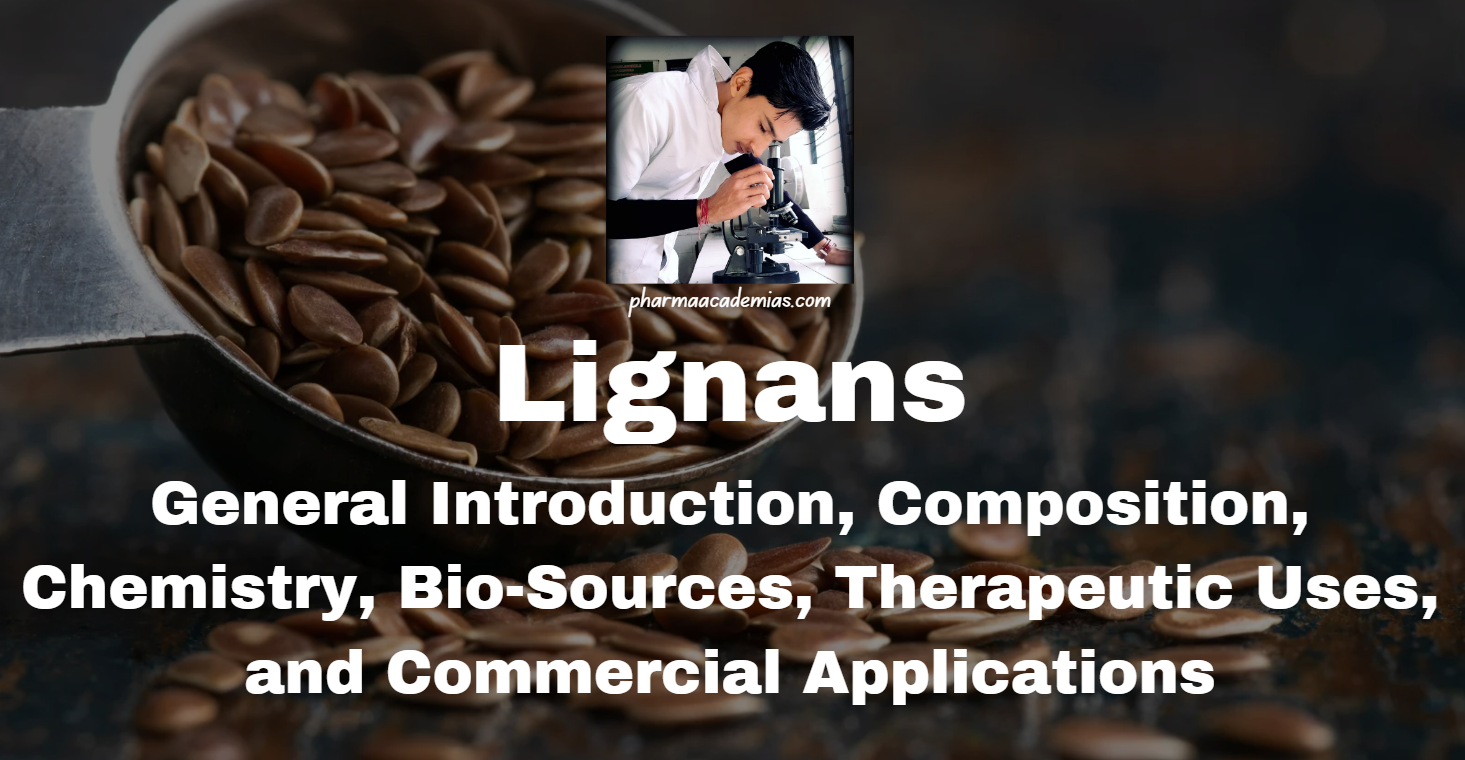General Introduction
Lignans are a diverse group of natural polyphenolic compounds found primarily in plants. They are a subgroup of non-flavonoid polyphenols, derived from the oxidative coupling of two phenylpropanoid units (C6-C3). Lignans are biosynthesized from phenylalanine through the shikimic acid pathway. They are structurally characterized by a 2,3-dibenzylbutane skeleton, forming a unique class of secondary metabolites with significant biological activities.

Lignans occur in various plant tissues such as seeds, roots, leaves, and fruits. They play crucial roles in plant defense mechanisms against pathogens and contribute to the structural integrity of the cell wall. In human nutrition, lignans are considered phytoestrogens because they can mimic or modulate the action of estrogen, influencing hormone-related activities in the body.
Composition and Chemistry
Lignans are dimeric phenylpropanoid compounds composed of two coniferyl alcohol residues linked by a β-β’ bond. The structural diversity of lignans is due to various modifications, such as oxidation, reduction, methylation, glycosylation, and cyclization. Lignans can be broadly classified into several types based on their structural features:
1. Dibenzylbutane Lignans: The most common type with a characteristic 2,3-dibenzylbutane skeleton. Example: Secoisolariciresinol.
2. Furofuran Lignans: Contain a tetrahydrofuran ring formed by a linkage between two aromatic rings. Example: Sesamin.
3. Furan Lignans: Feature a furan ring in their structure. Example: Podophyllotoxin.
4. Aryltetralin Lignans: Comprise a tetralin ring system. Example: Podophyllotoxin.
5. Cyclolignan: Possess a cyclohexane ring in their structure. Example: Cyclolariciresinol.
Chemical Structure:
Basic Structure: (C6-C3) – (C6-C3), representing two phenylpropanoid units.
Key Functional Groups: Methoxy (-OCH3), Hydroxyl (-OH), and Glycosidic Linkages (-O-Glc).
Bio-Sources
Lignans are found in a wide variety of plant sources. Some of the most lignan-rich foods include:
Flaxseeds: The richest known source of secoisolariciresinol diglucoside (SDG), which is converted into enterolignans in the human body.
Sesame Seeds: Contain sesamin and sesamolin, two unique lignans with potent antioxidant properties.
Whole Grains: Rye, wheat, barley, and oats are good sources.
Vegetables and Fruits: Cruciferous vegetables (like broccoli and cabbage), berries, and apricots contain significant amounts of lignans.
Legumes: Lentils, beans, and chickpeas.
Therapeutic Uses
Lignans have attracted considerable interest due to their broad range of pharmacological activities. Some of the therapeutic uses include:
1. Antioxidant Properties: Lignans scavenge free radicals and reduce oxidative stress, helping to prevent cellular damage and reducing the risk of chronic diseases like cancer, cardiovascular diseases, and neurodegenerative disorders.
2. Anti-cancer Activity: Lignans, such as podophyllotoxin, exhibit cytotoxic effects against various cancer cells by inhibiting topoisomerase II, an enzyme necessary for DNA replication. Derivatives like etoposide and teniposide are used as chemotherapeutic agents.
3. Phytoestrogenic Effects: Lignans can bind to estrogen receptors and exhibit weak estrogenic or anti-estrogenic effects, which may help in managing menopausal symptoms, breast cancer prevention, and other hormone-related conditions.
4. Cardioprotective Effects: Lignans like secoisolariciresinol and matairesinol are believed to lower the risk of cardiovascular diseases by reducing blood pressure, cholesterol levels, and improving endothelial function.
5. Anti-inflammatory and Immunomodulatory Properties: Lignans have shown the ability to modulate inflammatory pathways and the immune system, potentially helping to treat autoimmune and inflammatory diseases.
6. Antimicrobial Activity: Certain lignans possess antibacterial, antifungal, and antiviral properties, making them potential candidates for natural antimicrobial agents.
Commercial Applications
1. Pharmaceuticals: Etoposide and Teniposide, synthetic derivatives of the lignan podophyllotoxin, are used as chemotherapy drugs for treating various cancers, such as small cell lung cancer, testicular cancer, and lymphomas.
Lignan Supplements: Marketed for their antioxidant and estrogenic properties, lignan supplements are available in capsule, powder, and liquid forms.
2. Nutraceuticals: Lignans are increasingly added to functional foods and nutraceutical products for their health benefits, including cardiovascular support, antioxidant protection, and hormone regulation.
3. Cosmetics: Lignans are used in skincare products for their antioxidant properties, which help to protect the skin from oxidative damage and aging.
4. Food Industry: Flaxseed and sesame seed oils enriched with lignans are popular in the food industry for their health benefits. Flaxseed oil, in particular, is marketed for its high omega-3 fatty acid content and lignan content.
Conclusion
Lignans are a diverse group of polyphenolic compounds with a broad range of therapeutic applications and commercial uses. Their natural occurrence in various plants, coupled with their extensive pharmacological properties, make them an area of growing interest in the fields of medicine, nutraceuticals, and functional foods. As research continues to uncover their benefits and mechanisms, lignans are likely to become even more prominent in both clinical and commercial contexts.

